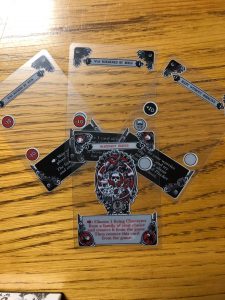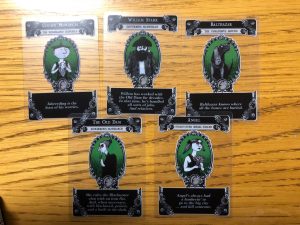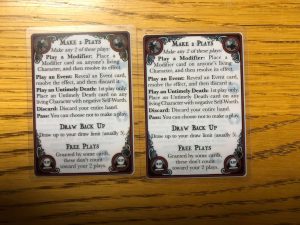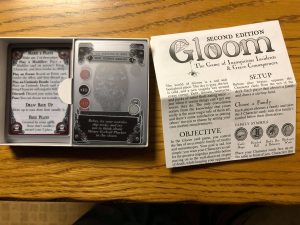Photo by Simon Berger on Unsplash
Table of Contents
I recently purchased and had the pleasure of playing Gloom, which is a dark card game with a creepy undertone not unlike A Series of Unfortunate Events. Since my goal this Halloween season is to discuss as many horror-themed things as possible, I thought now was as good a time as any to review it.
Hopefully, after reading my review, you’ll be able to decide whether or not you want to give it a try, too. Of course, beyond the review, I’ll also answer a couple basic questions about the game.
How Do You Play the Card Game Gloom?

Gloom is an interesting game. The basic game can support up to five players straight out of the box without any expansions. Each player gets to take control of one family, all of which are divided into different colors so you can tell which character cards belong to the same family.
Your goal? Kill all members of the family you’re controlling. But before you seal the deal, try to make them as unhappy as possible first by applying modifier cards to them.
The modifier card will have a numerical value on it which is positive or negative. Negative values subtract from a character’s self-worth score, while positive ones increase it. You want your own family to have the lowest self-worth possible before using another card to kill them, because you only get to count those negative values as points after their death.
Meanwhile, you mess with the other players by making their characters as happy as possible. You do this by applying modifier cards with positive values to their characters.
Sound simple? Well, there are cards you can use to throw a wrench into the gameplay. Event cards are cards you can play which describe a certain event taking place. The event can be anything, like allowing you to steal cards from an opponent’s hand or even bringing one of their characters back to life.
You can check out a more in-depth discussion of the rules in this YouTube video about Gloom gameplay.
Gloom Card Game Review
All right, now to get to the reviewing part. I’ve never really looked at card game reviews before, so I’m organizing my own in a way that might be strange.
I’m dividing it into a few different qualities that I think are important in a good card game:
- Gameplay – how fun the actual game itself feels.
- Quality of materials – how well-made the pieces and cards feel.
- Learning curve – how easy it is to learn to play the game.
- Replayability – how likely I am to play it again.
- Cost – how reasonable the price was, all other factors considered.
After discussing each of the aforementioned categories, I’ll assign each one a score ranging from one to five. One is terrible, five is the best.
Then, I’ll give the game an overall score, which will be all my other scores added up and averaged out. Voila! You’ll have a card game review at that point.
Gameplay

I thought playing the game was pretty fun…if you’re with the right people. You see, a big part of the game involves storytelling. You’ll play a modifier card that will say something brief about an event, like “Driven to Drink,” and then ideally you describe how it happened.
Some of the cards, including the ones that kill characters, get pretty crazy. Coming up with stories describing what led up to that point is oftentimes a challenge to your creativity. However, it’s fun to listen to the stories that people can come up with if they play along.
Such story-based gameplay might not appeal to everyone, though, and you might end up with a group of people who perhaps don’t feel comfortable telling elaborate stories. In a group like that, the game loses much of its character.
For that reason, while I think the overall gameplay is amusing, it really depends on who you’re playing with. This may not be a game to pull off the shelf for just anyone.
In terms of length, the game is reasonable. I was able to finish it in about an hour, but it could easily go on longer if you’re playing with people who have interrupt event cards, which they can play in response to your actions. (Magic: the Gathering players will be familiar with the concept.)
Score: 4
Quality of Materials

The cards themselves are made out of a thin, transparent material. The closest comparison I can give to them is the see-through sheets they used to put on overhead projectors in schools (and I might be revealing my age by saying so).
You’re not going to be able to rip these cards, which is nice. The drawback, I think, is that they’re super slippery. This makes shuffling both easier and paradoxically more difficult. Although they move through your hands easier, it’s simultaneously easier to drop them.
The reason why they’re transparent is that you’re supposed to stack cards on top of each other while still being able to read the bottom card. For example, you do this when you’re applying modifiers to characters. It looks neat, but I found that we sometimes ended up with so many modifiers stacked on top of a person, that you couldn’t really see their portrait anymore.
One thing I don’t like is that the rules sheet is just a single sheet of paper folded up inside the box. It’s kind of flimsy and could be ripped or lost easily. Make sure you keep it inside the box when you’re done playing.
The box itself is kind of small. Inside, there are two compartments that you store two stacks of cards in. Like the rules sheet, it feels a little flimsy, but I don’t really expect it to be particularly robust.
Score: 4
Learning Curve

The rules are entirely confined to one sheet of paper. Granted, it’s a double-sided sheet of paper, so the rules essentially take up two pages, but still – this is significantly less than you’ll find with some other card games.
Because it isn’t just pages upon pages of rules, I’d say it’s somewhat easy to learn. I and the person I played with were able to pick it up fairly quickly.
However, I do have a gripe with that rule sheet. I wish it was printed in a small booklet divided into orderly subsections with a table of contents. I feel as if it would have made it easier to find answers when we had questions about different interactions.
Score: I swear I’m not trying to do this on purpose…but 4.
Replayability
There are some card games you buy, play once, then put back up on your shelf, never to take them down again. I myself own a few of those. Would I consider Gloom to be one of them?
To be honest with you, I’ve never taken it out after playing it the first time. But this isn’t because I haven’t wanted to play it – it’s because, due to social distancing, I haven’t exactly had an opportunity to play it with other people.
I can see how the game might get repetitive, especially if you’re playing with the same people over and over again. But if you’re playing with new people or people who really know how to spin a yarn, then I think it does have replay value, even if you don’t buy the expansions.
But it doesn’t have the randomness of a more extensive board game, like Arkham Horror, for example. For that reason, I wouldn’t give it a perfect score in replayability.
Score: 3.5
Cost

Card and board games can get crazily expensive. If you’re living on a budget, you might not be able to justify spending a lot of money on them. Heck, even if you have a larger budget, you might not see a reason to spend hundreds or more on a game.
Is Gloom expensive? Because prices are subject to change, I won’t quote an exact number, but you can click here to check the price on Amazon.
For what it is – just a deck of cards in a small box – I think it’s reasonably priced. Of course, our opinions on that might differ. Consider, though, the quirky artwork that went into the making of the cards and their tough material.
Score: 5
Overall Score
All right, totaling up my scores and averaging them out, Gloom gets an overall score of 4.1. That’s not surprising, since I felt like most of its qualities were at least above average.
So, would I recommend it? Yes! It can be pretty affordable, and it’s perfect for creative horror fans. I don’t know that I would say it’s child-friendly, but it could be a great game for adults.
Where Can I Buy Gloom?
You can buy Gloom in a lot of places online. You can even get a virtual version on Steam, if you feel so inclined.
I personally bought it from Amazon, because I wanted to have a physical copy of it to play at home. If you’re interested in doing so, you can click on any of the previous links I provided, or just click here to view the listing on Amazon.
Wrap Up
I hope this post helped you make up your mind about Gloom. It’s a pretty solid game that I’d recommend playing at least once.
However, Gloom is just one example of a card game that’s perfect for lovers of all things spooky or for those looking to get into a Halloween spirit. If you’d like to see more examples of creepy card games, don’t forget to check out our post about the best horror-themed card games for adults.
